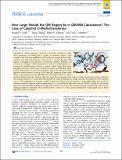| dc.contributor.author | Zhang, Jianyu | |
| dc.contributor.author | Klinman, Judith P. | |
| dc.contributor.author | Martínez, Todd J. | |
| dc.contributor.author | Kulik, Heather Janine | |
| dc.date.accessioned | 2017-04-12T14:26:26Z | |
| dc.date.available | 2017-04-12T14:26:26Z | |
| dc.date.issued | 2016-10 | |
| dc.date.submitted | 2016-08 | |
| dc.identifier.issn | 1520-6106 | |
| dc.identifier.issn | 1520-5207 | |
| dc.identifier.uri | http://hdl.handle.net/1721.1/108064 | |
| dc.description.abstract | Hybrid quantum mechanical–molecular mechanical (QM/MM) simulations are widely used in studies of enzymatic catalysis. Until recently, it has been cost prohibitive to determine the asymptotic limit of key energetic and structural properties with respect to increasingly large QM regions. Leveraging recent advances in electronic structure efficiency and accuracy, we investigate catalytic properties in catechol O-methyltransferase, a prototypical methyltransferase critical to human health. Using QM regions ranging in size from reactants-only (64 atoms) to nearly one-third of the entire protein (940 atoms), we show that properties such as the activation energy approach within chemical accuracy of the large-QM asymptotic limits rather slowly, requiring approximately 500–600 atoms if the QM residues are chosen simply by distance from the substrate. This slow approach to asymptotic limit is due to charge transfer from protein residues to the reacting substrates. Our large QM/MM calculations enable identification of charge separation for fragments in the transition state as a key component of enzymatic methyl transfer rate enhancement. We introduce charge shift analysis that reveals the minimum number of protein residues (approximately 11–16 residues or 200–300 atoms for COMT) needed for quantitative agreement with large-QM simulations. The identified residues are not those that would be typically selected using criteria such as chemical intuition or proximity. These results provide a recipe for a more careful determination of QM region sizes in future QM/MM studies of enzymes. | en_US |
| dc.description.sponsorship | Burroughs Wellcome Fund (Career Award at the Scientific Interface) | en_US |
| dc.language.iso | en_US | |
| dc.publisher | American Chemical Society (ACS) | en_US |
| dc.relation.isversionof | http://dx.doi.org/10.1021/acs.jpcb.6b07814 | en_US |
| dc.rights | Article is made available in accordance with the publisher's policy and may be subject to US copyright law. Please refer to the publisher's site for terms of use. | en_US |
| dc.source | Kulik | en_US |
| dc.title | How Large Should the QM Region Be in QM/MM Calculations? The Case of Catechol O-Methyltransferase | en_US |
| dc.type | Article | en_US |
| dc.identifier.citation | Kulik, Heather J. et al. “How Large Should the QM Region Be in QM/MM Calculations? The Case of Catechol O -Methyltransferase.” The Journal of Physical Chemistry B 120.44 (2016): 11381–11394. © 2016 American Chemical Society | en_US |
| dc.contributor.department | Massachusetts Institute of Technology. Department of Chemical Engineering | en_US |
| dc.contributor.approver | Kulik, Heather J | en_US |
| dc.contributor.mitauthor | Kulik, Heather Janine | |
| dc.relation.journal | The Journal of Physical Chemistry B | en_US |
| dc.eprint.version | Final published version | en_US |
| dc.type.uri | http://purl.org/eprint/type/JournalArticle | en_US |
| eprint.status | http://purl.org/eprint/status/PeerReviewed | en_US |
| dspace.orderedauthors | Kulik, Heather J.; Zhang, Jianyu; Klinman, Judith P.; Martínez, Todd J. | en_US |
| dspace.embargo.terms | N | en_US |
| dc.identifier.orcid | https://orcid.org/0000-0001-9342-0191 | |
| mit.license | PUBLISHER_POLICY | en_US |
| mit.metadata.status | Complete | |
